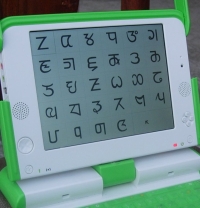Checking in with OLPC Nepal, we find them currently focused on stimulating content communities - finding ways to entice educators and artisans to produce content for the Children's Machine XO. But its not an easy effort:
It will be hard to convince veteran teachers to use a radically different method of instruction. However, we can convince the next generation of educators who have recently graduated or are still in university. If we can win their support they will ensure that OLPC is an integral part of their respective national education systems in the long run.They've developed a few different ideas that could be motivating for more than just Nepali educators, most based around certificates with are both cheap to give yet high in social value.
Over on the OLPC Library list, Nathaniel Berger is wondering the same thing - how to motivate educators to create X0 content:
For weeks I have been talking with faculty members here at Ohio University about how we might best participate in the project, and in all honesty, after reading though the library digests, and much of the wiki, we are still left unsure.He is sure on two very compelling aspects of how to teach art, especially fine art, once it is on the Children's Machine XO. Two aspects that sound so easy and common-sense but will be often difficult to achieve in settings like Nepal, where so little art content is digitized:
- Overcome the high-brow stigma that Fine Arts has garnered, and present the content in a clean, concise manner that keeps kids interested.
- Present works that are relevant to the specific region, country, and/or culture in which the child lives. (Appalachian children immediately gain access to Appalachian art, and are presented with how that art is relevant to other art, and the world in general.)
After working with an engineer from Cisco on networking and one from Boston on the word-processing software, members of the OSU Open Source Lab started a new project. A team of five undergraduate students, Burns, Gallardo, Brad Morgan, Josh Schonstal, and Sarah Cooley, are working with Real Networks, Inc. on a media player for the laptop. Burns said Real (of Real Player fame) recently gave the OSU Open Source Lab a $500,000 grant to work on the project.If educators are interested in developing content and curriculum for the OLPC XO, find a resourceful entity with a similar goal and investigate possible collaborations. I would think that Blackboard or Riverdeep would be a good start for both guidance and grants to get educators involved in One Laptop Per Child. Specifically for art education, look to the plethora of artistic foundations and cultural patrons that fund them.
As Nicholas Negroponte shows, you get attention when you talk about children + education.




Wayan, great post
thanks plugging our work and thanks for letting me know about Nathan and the Open Source Lab. I already have great respect for OSL but it hadn't occurred to me to that they might be able to help. I will definitely contact both Nathan and the OSL.
I immediately have two ideas for OSL
1) Create a very light and fast version of GIMP that will run on the XO or another inexpensive PC like the Classmate+Mandriva!
2) Create a very light and fast video-editing program
Both of those tools would be ideal for stimulating the uber-blog-a-verse that Eben Moglen spoke about and that Ethan Zuckerman seems to be interested in stimulating. Perhaps Ethan could help w/ this as well.
Blackboard may want to help but would they play well w/ Moodle?
Just one correction, the script in XO's screen in the picture is Limbu (a language spoken in Nepali Limbu community) script not Nepali.
Conversations about another key software component had been taking place between OLPC and RealNetworks administrators. Creators of the RealPlayer® audio/video program, RealNetworks was interested in seeing its open source Helix™ multimedia player modified for use in the children’s laptop. Impressed by the speed and quality of Gallardo’s work, OLPC project managers recommended that RealNetworks contact the two OSU students.
A series of phone calls with Burns, Gallardo and others led to an in-person visit in which RealNetworks engineers traveled from Seattle headquarters to see the Open Source Lab for themselves.
They found great possibilities for the lab’s development. “We recognized upfront that the team had significant potential to really expand their horizons and develop core expertise in building open source digital media applications,” Schwarz said. “We’re expecting great things out of the Open Source Lab for the OLPC project and beyond.”
The RealNetworks gift will significantly strengthen the lab and “provide the type of environment that students like Justin and Mike can thrive in,” said Shay Dakan, director of OSU Network Services. Part of the gift will fund a fulltime engineer who will mentor students working on the laptop applications."
http://osuosl.org/node/60